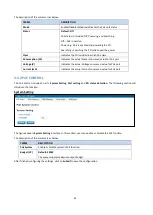
48
3.4 REDUNDANCY
Redundancy role on the network is to help protect critical links against failure, protects against network loops, and
keeps network downtime at a minimum. Sustainable, uninterrupted data communication network is critical for
industrial applications. Network Redundancy allows user to set up redundant loops in the network to provide a
backup data transmission route in the event that a cable is inadvertently disconnected or damaged. This switch
supports Rapid Spanning Tree Protocol (RSTP)/Multiple Spanning Tree Protocol (MSTP) and ITU-T G.8032 v1/v2
Ethernet Ring Protection Switching (ERPS). ERPS (Ethernet Ring Protection Switching) or ITU-T G.8032 is a loop
resolution protocol, just like STP. Convergence time is much quicker in ERPS. Unlike in STP, most of the ERPS
parameters are management configured – which link to block in the start etc. Normally ERPS is implemented with-in
the same administrator domain, there by having control on the nodes participating in the Ring. This technology
provides sub-50ms protection and recovery switching for Ethernet traffic. This is a particularly important feature for
industrial applications, since it could take several minutes to locate the disconnected or severed cable.
3.4.1 RSTP SETTINGS
This page allows select the RSTP mode and configuring the global RSTP Bridge Configuration.
The STP mode includes the
STP
,
RSTP
,
MSTP
and
Disable
. User can select the STP mode for user system first. The
default mode is RSTP enabled. After user selects the STP or RSTP mode; user should continue to configure the global
Bridge parameters for STP and RSTP. If user selects the MSTP mode, user need go to MSTP Configuration page.
Spanning Tree Protocol (STP)
STP is a Layer 2 link management protocol that provides path redundancy while preventing loops in the network. For
a Layer 2 Ethernet network to function properly, only one active path can exist between any two stations.
Spanning-tree operation is transparent to end stations, which cannot detect whether they are connected to a single
LAN segment or a switched LAN of multiple segments.
Rapid Spanning Tree Protocol (RSTP)
If the destination from a switch is more than one path, it will lead to looping condition that can generate broadcast
storms in a network. The spanning tree was created to combat the negative effects of message loops in switched
















































